Home Decor
DIY Rustic Coat Rack in 7 Easy Steps
Create a unique and functional rustic coat rack in just 7 easy steps, and discover the secrets to making it truly exceptional.
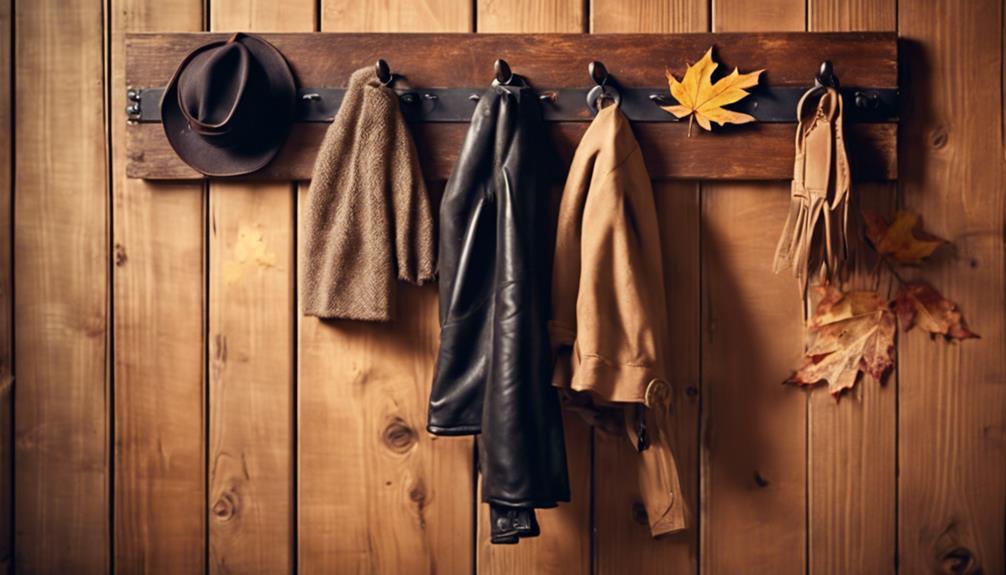
You're about to create a rustic coat rack that exudes charm and functionality in just 7 easy steps. First, gather essential supplies like sturdy wood, durable hooks, and screws. Next, prepare the wood surface by sanding, cleaning, and stripping away any old finish. Then, assemble the frame, attach the hooks securely, and add a decorative touch with unique knobs or monograms. Mount the coat rack safely using heavy-duty hooks and anchors, and finally, inspect and refine your creation. By following these steps, you'll have a one-of-a-kind coat rack that complements your home's rustic charm – and with a little more effort, you'll uncover the secrets to making it truly exceptional.
Key Takeaways
• Choose the right wood and durable hooks to ensure a sturdy and visually appealing coat rack.
• Sand and clean the wood thoroughly to create a smooth surface for a rustic finish.
• Assemble the frame by cutting and joining wood boards, and pre-drill holes for hooks and screws.
• Attach hooks evenly spaced and securely, testing stability with varying weights for peace of mind.
• Mount the coat rack to the wall using heavy-duty hooks, anchors, and locating wall studs for strength.
Gather Essential Supplies
What essential supplies will you need to create a rustic coat rack that's both functional and visually appealing? To get started, you'll need a few key materials.
First, choose a sturdy and visually appealing wood that fits your rustic design. This will serve as the backbone of your coat rack, so select a type that's both durable and aesthetically pleasing.
Next, you'll need some durable hooks that complement your rustic design. These will be responsible for holding your jackets, hats, and bags, so make sure they're up to the task.
You'll also need screws to attach the hooks to the wood. Be sure to select screws that are the correct size for secure attachment.
Additionally, you'll need a drill to make the necessary holes for the screws, as well as a measuring tape to guarantee accurate measurements.
With these essential supplies in hand, you'll be well on your way to creating a beautiful and functional rustic coat rack.
Prepare the Wood Surface
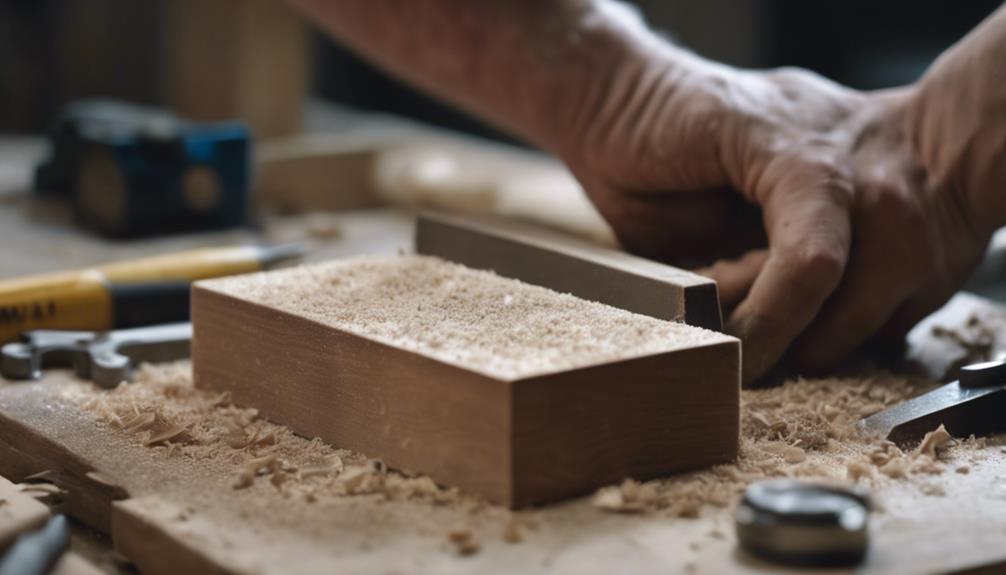
As you prepare the wood surface, you'll need to focus on sanding, cleaning, and removing any old finishes to guarantee a smooth, even base for your rustic coat rack.
You'll want to sand the wood smooth, removing any rough edges or imperfections, and then thoroughly clean the surface to eliminate dust and debris.
Sand the Wood Smooth
With your DIY coat rack project underway, you'll need to sand the wood smooth to prepare the surface for staining or painting. This important step guarantees a uniform and polished finish for your rustic wood coat rack.
To begin, grab a piece of fine-grit sandpaper and start smoothing out any rough spots or imperfections on the wood surface. Remember to sand in the direction of the wood grain to avoid creating scratches or marks on the surface. Be meticulous and sand all edges and corners evenly, making sure to cover every inch of the wood.
Once you've finished sanding, wipe down the wood with a tack cloth or damp cloth to remove any dust or debris. Properly sanding the wood will create a clean canvas for staining or painting in the next steps of your DIY project.
Remove Old Finish Completely
You'll need to strip away any existing finish or imperfections on the wood surface to ensure a successful stain or paint job, so grab your sanding tools and get to work. Sanding the wood surface thoroughly is essential to remove any old finish, ensuring a smooth surface for your new coat. Use a sanding block or orbital sander to efficiently remove the old finish, and don't forget to sand all corners and edges to create a seamless surface.
| Sanding Tool | Effectiveness |
|---|---|
| Sanding Block | 8/10 |
| Orbital Sander | 9/10 |
| Hand Sanding | 6/10 |
| Electric Sander | 8.5/10 |
Clean the Surface Thoroughly
Clean the wood surface thoroughly with a damp cloth or a mild cleaning solution to remove any residues or contaminants that might impact the finish. This important step guarantees the wood is free of dust, dirt, and debris, allowing the stain to adhere evenly and preventing imperfections in the finish. You'll be surprised at how a simple cleaning can make a huge difference in the final result.
After cleaning, take a few minutes to lightly sand the wood surface. This will smooth out any rough patches or imperfections, giving your coat rack a professional-looking finish. Remember, properly preparing the wood surface is key to achieving a smooth, flawless finish.
Assemble the Coat Rack Frame
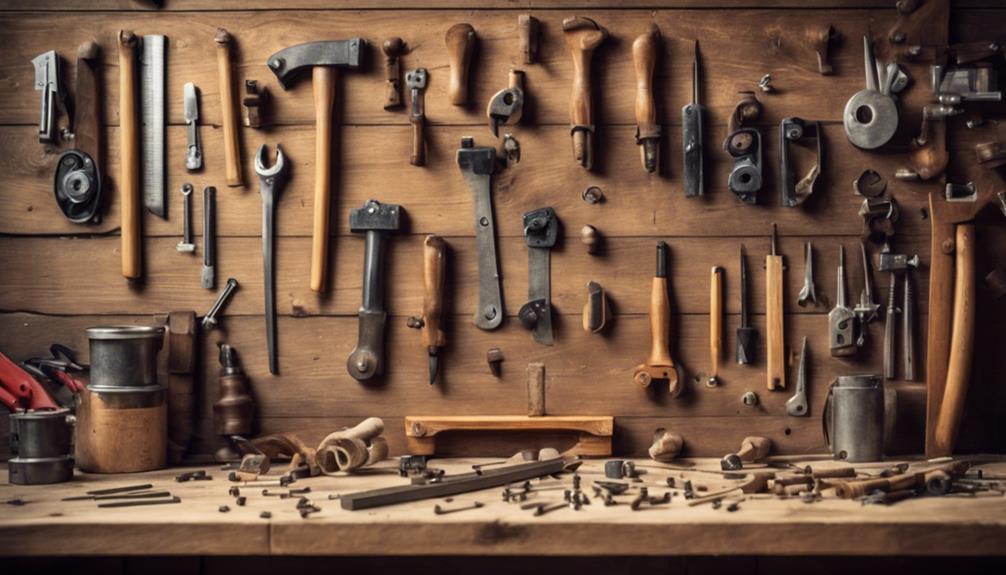
Measure and cut the wood boards to the desired length for the coat rack frame, taking care to guarantee the pieces fit together seamlessly.
As you assemble the coat rack frame, it's crucial to make sure the boards fit together securely, creating a sturdy structure that can hold the weight of your coats and accessories. To do this, join the boards using screws or wood glue, making sure they're level and straight by using a level during assembly.
Consider adding additional support or braces for extra stability, depending on the size of your coat rack.
As you work on your DIY project, remember to predrill holes before attaching the hooks or mounting hardware to prevent splitting the wood.
Attach Rustic Hooks Securely
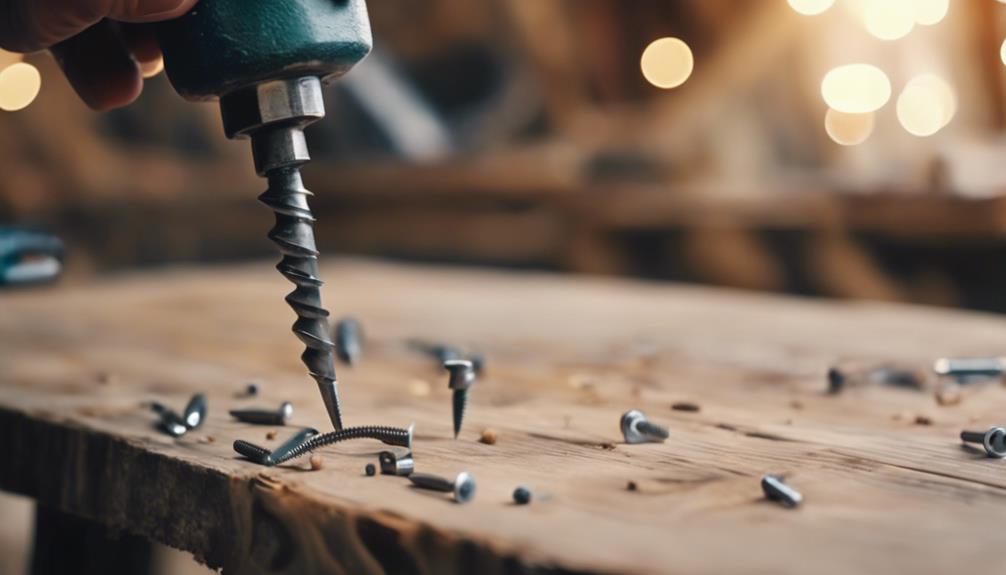
With your coat rack frame assembled, it's time to add the rustic hooks that will hold your outerwear, and it's important to attach them securely to guarantee they can bear the weight of your coats and accessories.
To do this, you'll need to pre-drill pilot holes in the wood to prevent splitting when attaching the rustic hooks. This step is essential, as it will make sure the hooks hold firmly and don't damage the wood.
Place the hooks evenly spaced on the front of the coat rack for a balanced look. When attaching the hooks, make sure the screws are long enough to secure them firmly to the wood.
Once the hooks are attached, test the stability of the coat rack by hanging items of varying weights to make sure the hooks are securely attached. This will give you peace of mind, knowing your coat rack can hold everything from light scarves to heavy coats.
Add a Decorative Touch
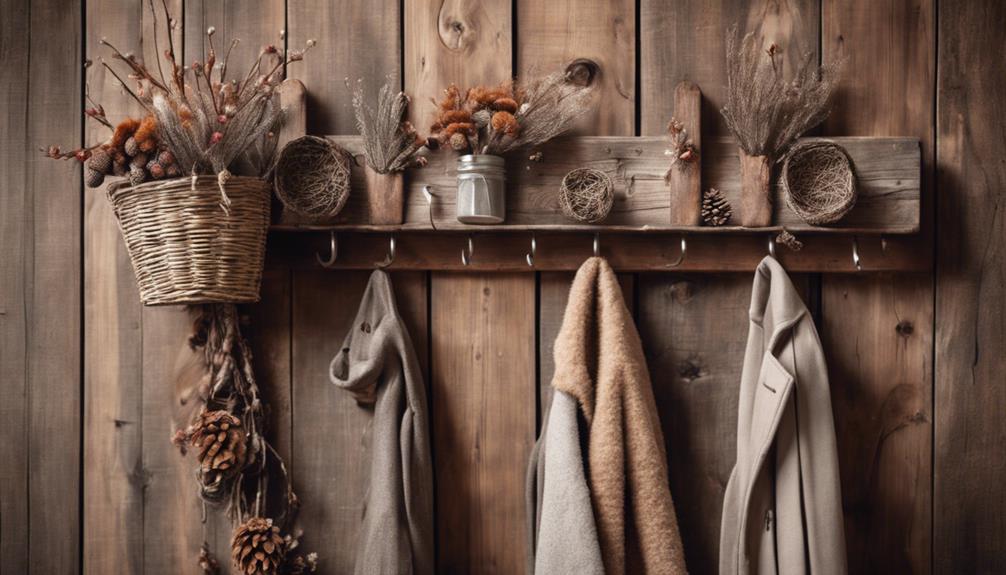
Add a personal touch to your rustic coat rack by incorporating decorative elements that reflect your personal style and complement your home's aesthetic. You can enhance the aesthetic appeal of your coat rack with decorative elements like rustic hooks or unique knobs. Consider adding a shelf above the coat rack for additional storage and display space.
| Decorative Elements | Description |
|---|---|
| Rustic Hooks | Add a touch of rustic charm to your coat rack |
| Shelf | Provide additional storage and display space |
| Monogrammed Hooks | Personalize your coat rack with customized hooks |
| Mirror | Add a functional and decorative touch |
| Distressed Finish | Achieve a unique, weathered look |
You can also personalize the coat rack with monogrammed hooks or painted designs for a unique look. Experiment with different finishes, such as distressed paint or weathered wood, to achieve a desired decorative effect. By incorporating these decorative elements, you can create a rustic coat rack that not only serves a functional purpose but also adds a touch of personality to your home's decor.
Mount the Coat Rack Safely
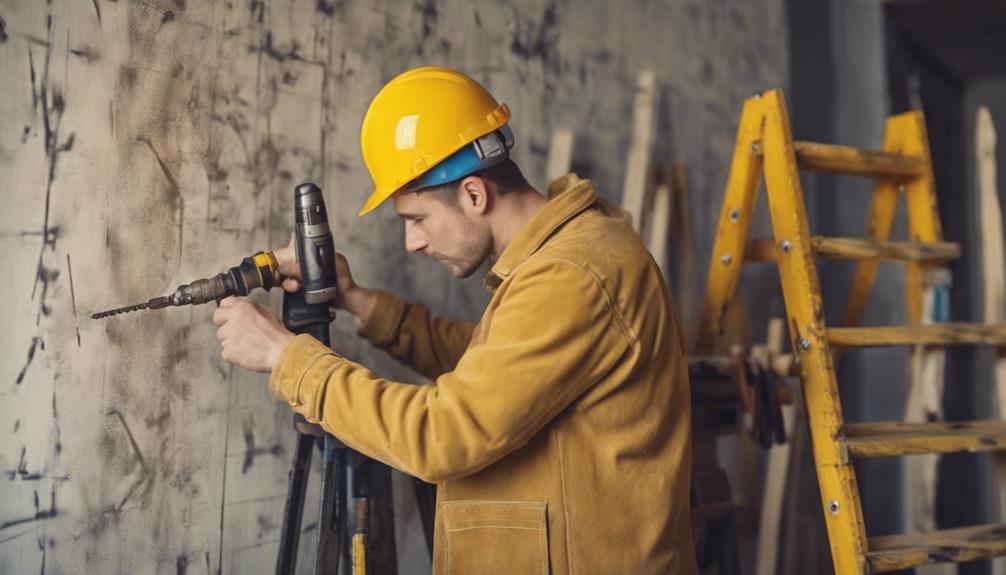
Now that your rustic coat rack is complete, it's time to securely attach it to the wall.
You'll want to explore wall anchor options that fit your specific needs, and master secure mounting techniques to guarantee your coat rack doesn't become a safety hazard.
Wall Anchor Options
You'll need to select the appropriate wall anchor to guarantee your DIY rustic coat rack stays securely mounted on your drywall. A sturdy wall anchor is essential to prevent your coat rack from crashing to the floor, taking your coats, hats, and bags with it.
When choosing a wall anchor, take into account the weight capacity of your coat rack. Here are three common wall anchor options to ponder:
- Plastic Expansion Anchors: Suitable for light to medium weight items, these anchors provide a secure hold without damaging the drywall.
- Toggle Bolts: Ideal for heavier items, toggle bolts can support more weight and are a great option for coat racks with multiple hooks.
- Molly Bolts: Providing strong support, molly bolts are versatile and can be used on various wall types, making them a great choice for your DIY project.
Remember to check the weight capacity of the wall anchors to make sure they can hold your coat rack securely. By selecting the right wall anchor, you'll enjoy a sturdy and reliable coat rack that will serve you well for years to come.
Secure Mounting Techniques
With your wall anchor chosen, it's time to focus on secure mounting techniques to make sure your DIY rustic coat rack stays firmly in place. You want to guarantee that your coat rack can hold the weight of your jackets, hats, and accessories without falling off the wall. To achieve this, it's important to follow some essential mounting techniques.
| Mounting Technique | Description | Importance |
|---|---|---|
| Use heavy-duty hooks | Provides stability and support | High |
| Locate wall studs | Adds strength and durability | High |
| Pre-drill holes | Prevents wall damage and ensures secure attachment | Medium |
When mounting your coat rack, make sure to pre-drill holes in the wall for screws to prevent damage and ensure a secure attachment. It's also important to check the weight capacity of the mounting hardware to ensure it can support the coat rack. If wall studs are not available for mounting, consider using anchors for additional support. By following these mounting techniques, you can rest assured that your rustic DIY coat rack will remain securely in place.
Final Touches and Inspection
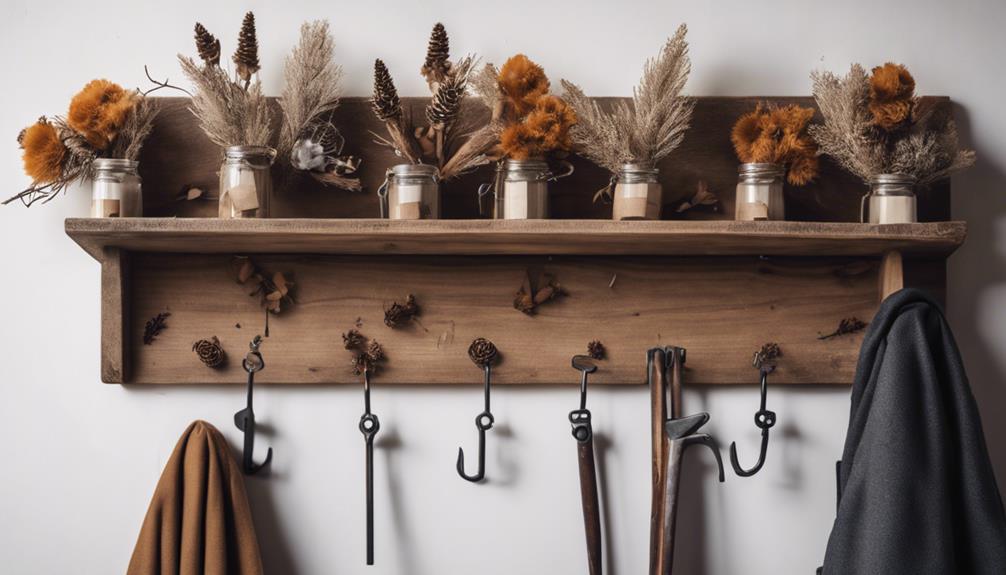
Sand the assembled boards thoroughly to achieve a smooth and even surface for staining, making sure that every inch of the wood is prepared for the rustic look you're aiming for.
Now, it's time to add the final touches to your DIY rustic coat rack project.
Next, apply a coat of your preferred stain color evenly to enhance the rustic look of the coat rack. Consider adding multiple coats of stain for a darker finish or to achieve the desired color depth.
Here are some important final steps to keep in mind:
- Install rustic hooks onto the front of the coat rack with even spacing for hanging items, such as coats, hats, and bags.
- Confirm that the coat rack is securely mounted to the wall using heavy-duty mounting hooks for stability and safety.
- Double-check that all parts are securely attached and the coat rack is level.
With these final touches, your DIY rustic coat rack is now complete and ready to hold your favorite coats, hats, and accessories.
This project is a great example of how DIY projects can add a personal touch to your home decor, and with a little creativity, you can create a unique coat hanger that reflects your personal style.
Frequently Asked Questions
How Can I Make My Own Coat Rack?
You're looking to create your own coat rack from scratch. That's a great DIY project!
To get started, decide on the design and material you want to use. Measure and cut the wood to the desired length, then pre-drill holes for the screws that will attach the hooks.
Choose rustic hooks for a farmhouse-style look, and don't forget to install heavy-duty mounting hooks for stability.
What Wood to Use for a Coat Rack?
When choosing wood for your coat rack, you're spoiled for options. Did you know that reclaimed barn wood is a top pick, with 70% of DIYers opting for its unique, weathered charm?
Consider oak, pine, or cedar for their durability and aesthetic appeal. Make sure the wood is thick enough to support the weight of coats and items, and don't forget to treat or seal it to prevent warping or damage over time.
How to Make Wooden Coat Hooks?
When creating wooden coat hooks, you'll want to select sturdy wood, like oak or maple, to guarantee durability. Use a drill to create evenly spaced holes for the hooks, then securely attach them using screws or nails.
Consider adding a protective finish, like varnish or lacquer, to prevent damage. You can also customize the hooks by staining or painting them in a color that complements your design, adding a personal touch to your project.
What Is the Spacing for Coat Rack Hooks?
When determining the spacing for your coat rack hooks, you'll want to take into account a few factors. Typically, hooks should be spaced between 5-7 inches apart to accommodate different sizes of coats and accessories.
This range allows for a balanced and visually appealing look, while also ensuring efficient organization and easy access to your belongings.
Conclusion
As you step back to admire your handiwork, the rustic coat rack's distressed finish and rugged hooks seem to transport you to a cozy cabin in the woods. Coincidentally, the exact same atmosphere you envisioned when you started this DIY project.
With every coat and hat hung neatly, the rustic charm is undeniable. You've not only created a functional piece but also a conversation starter.
Give yourself a pat on the back – you've successfully transformed a few wooden planks into a one-of-a-kind masterpiece.
Vivienne – Your Content Companion Vivienne is your content companion, curating valuable tips, advice, and inspiration to guide you on your home decor journey. From insightful blog posts to informative product descriptions, she’s here to empower you with the knowledge you need to create your dream space.
Home Decor
Homemade Bird Nest Crafting: 3 Simple Steps
Prepare to take flight into the world of creative nesting, where natural beauty and personal touches come together in a unique decorative piece.
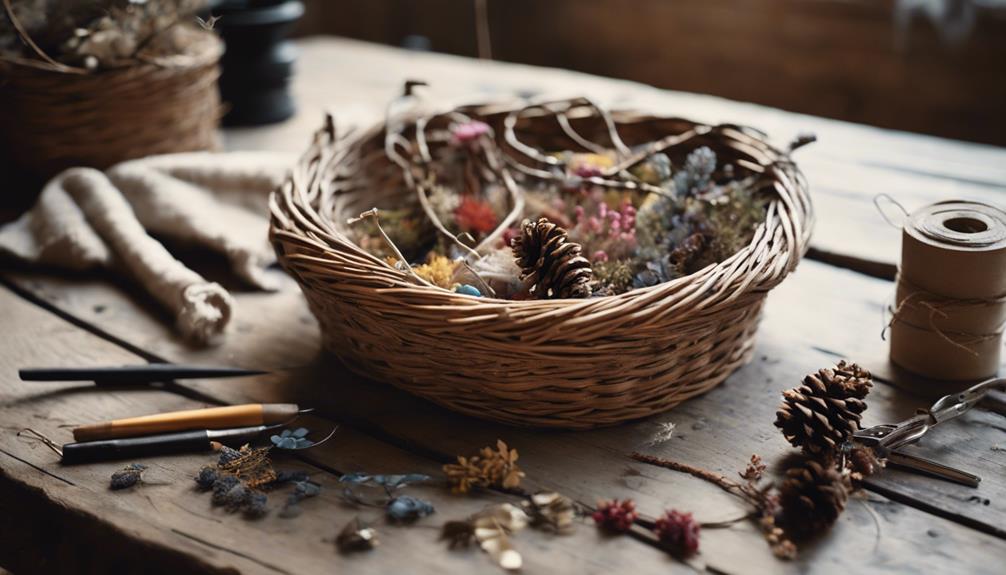
To craft a homemade bird nest, start by gathering natural materials like dried grass, twigs, and leaves from your yard or local parks. Next, mold the nest shape by wrapping angel hair vine filler around a bowl, securing it with thin wire. Finally, add decorative elements like feathers, dried flowers, or small twigs to enhance the natural look. Personalize your nest with ribbons, fabric scraps, or small ornaments to make it unique. With these three simple steps, you'll have a natural haven for birds and a stunning decorative piece for your home – and that's just the beginning of your creative journey.
Key Takeaways
• Gather natural materials like dried grass, twigs, and Spanish moss to mimic the bird's natural environment.
• Create a nest structure by wrapping angel hair vine filler around a bowl and securing it with thin wire.
• Add decorative elements like Easter eggs, feathers, and dried flowers to enhance the natural look.
• Personalize your bird nest with ribbons, fabric scraps, or small ornaments to make it unique.
• Experiment with different elements to unleash your creativity and make your DIY project special.
Gathering Natural Materials
Head outdoors to scour your yard, local parks, or online retailers for natural materials like dried grass, twigs, leaves, and Spanish moss that will give your DIY bird nest an authentic look. This is the first step in making a homemade bird nest that will attract birds to your backyard.
You'll want to gather materials that mimic the natural environment, allowing your DIY nest to blend in seamlessly. As you forage for materials, keep in mind the type of bird you're trying to attract, as different species have unique nesting preferences.
Once you've collected your materials, prepare your workspace by covering it with craft paper, wearing gloves, and working in a well-ventilated area to prevent mess. With your materials and workspace ready, you'll be set to start crafting your DIY bird nest, making it an inviting home for your feathered friends.
Crafting the Nest Structure
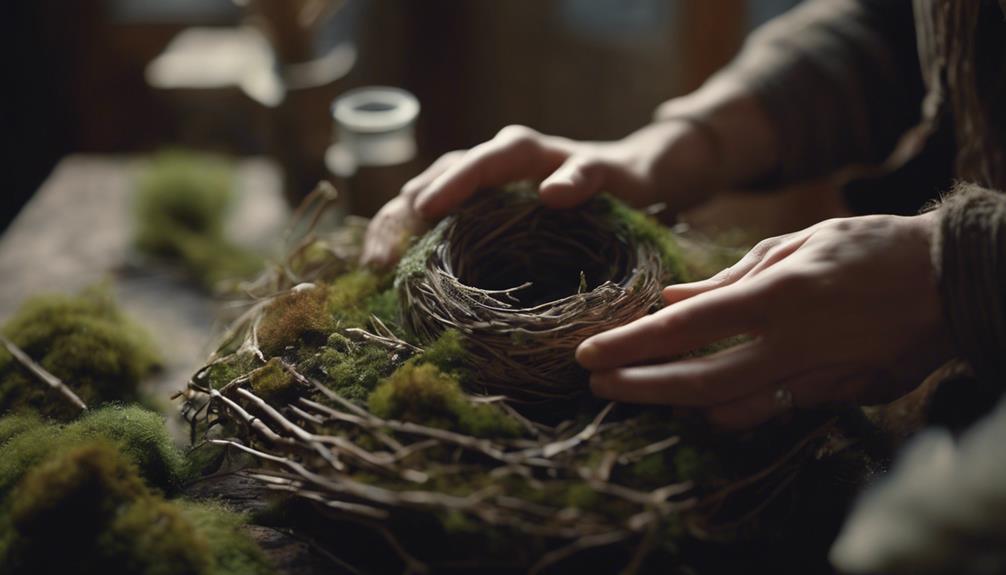
With your natural materials and workspace prepared, you're ready to start crafting the nest structure, the foundation of your DIY bird nest. This is the most essential step in creating a realistic bird nest, as it provides the base shape and form of the nest.
To craft the nest structure, follow these steps:
- Wrap the angel hair vine filler around a bowl to mold the nest shape, using thin wire to secure it in place.
- Continue wrapping the vine filler around the bowl, overlapping the layers to create a sturdy base.
- Secure the sides of the nest together using thin wire, and trim any excess filler.
- Once the nest is formed, carefully remove it from the bowl.
Adding Final Touches
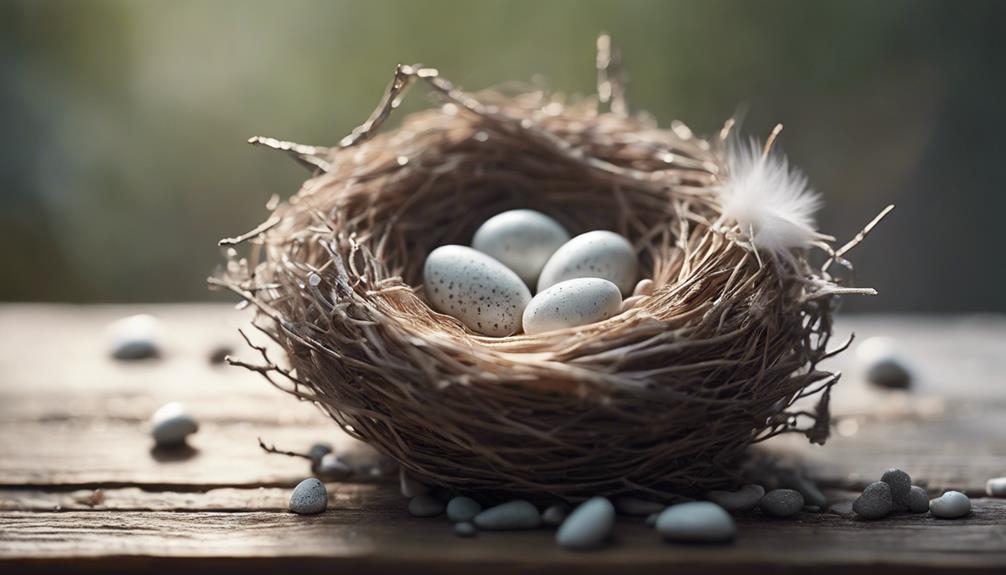
You can now add the perfect finishing touches to your DIY bird nest by incorporating decorative elements that reflect your personal style and flair.
Add a pop of color and texture to your bird nest with decorative Easter eggs or faux bird eggs, which can be easily attached using a hot glue gun.
To enhance the natural look of your nest, incorporate feathers, dried flowers, or small twigs, which will add a touch of whimsy and authenticity to your decoration.
Consider adding a miniature nest or a tiny bird figurine to create a charming and unique centerpiece.
Experiment with different elements like ribbons, fabric scraps, or small ornaments to personalize and customize your bird nest decoration.
Don't be afraid to get creative and try out new ideas – after all, customization is what makes your DIY project truly special.
Frequently Asked Questions
How to Build a Bird Nest Step by Step?
When you're wondering how to build a bird nest step by step, start by gathering natural materials like twigs, grass, and feathers for an authentic look.
Next, use a bowl as a mold to shape the nest and hold it together with thin wire.
How to Make a Craft Nest for Kids?
When you're looking to make a craft nest for kids, start by gathering materials like construction paper, glue, a bowl, and a paintbrush.
Cut the paper into strips and layer them inside the bowl, coated with a glue and water mixture.
Encourage kids to experiment with different colors and textures to create a unique nest, adding details like eggs or birds for a realistic touch.
How Do Birds Build Nests for Kids?
You might wonder how birds build their nests, and it's fascinating to learn about their unique techniques. Birds collect materials like twigs, leaves, and mud, carefully arranging them to create a safe space for their eggs.
Some species weave intricate nests, while others dig simple depressions in the ground. By observing birds build nests, you'll appreciate their remarkable resourcefulness and adaptability in using their surroundings to create homes.
How to Make Birds Nest With Paper?
Are you curious about how to make a bird's nest with paper? You're in luck!
To create a realistic bird's nest, you'll need to cut paper strips about 1/4 inch thick, mix Elmer's glue with water, and arrange the strips criss-crossing inside a bowl lined with plastic wrap.
You can experiment with different colors and textures of paper to create a unique design.
Conclusion
As you carefully place the final twig, your homemade bird nest begins to resemble a cozy little home, a tribute to nature's intricate design.
Like a master weaver, you've intertwined twigs, leaves, and feathers to create a snug sanctuary, a symbol of hope and new life.
Just as the nest cradles its precious cargo, your creativity has given birth to something beautiful, a reminder that even the smallest acts of craftsmanship can hold profound significance.
Vivienne – Your Content Companion Vivienne is your content companion, curating valuable tips, advice, and inspiration to guide you on your home decor journey. From insightful blog posts to informative product descriptions, she’s here to empower you with the knowledge you need to create your dream space.
Home Decor
Remarkable Hallway Makeover
Witness the transformation of a mundane hallway into a stunning focal point, and discover the creative secrets behind this remarkable makeover.
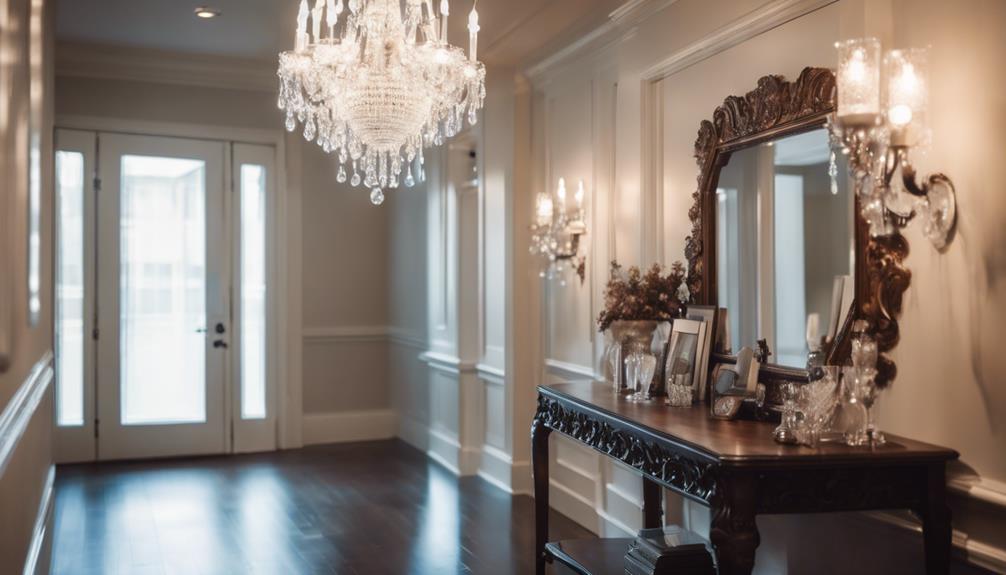
As we started on our remarkable hallway makeover, we transformed this often-overlooked space into a stunning focal point through careful planning, meticulous execution, and creativity. We initiated the transformation with prep work, selecting the perfect paint swatch, Evergreen Fog SW 9130, and a satin finish for a cohesive look. Clever sticker removal techniques and personalized decor and artwork added a unique touch. Thoughtful arrangement of artwork and decor created harmony, while mixing sizes, styles, and unconventional items added visual interest. To achieve a balanced look, we considered size, color, and style, and our hard work paid off, resulting in a beautiful, inviting space that showcased our personal style – and that's just the beginning of our remarkable hallway makeover journey.
Key Takeaways
• A remarkable hallway makeover begins with prep work, paint swatches, and clever sticker removal techniques for a fresh start.
• Selecting a cohesive paint color scheme, such as Evergreen Fog SW 9130, sets the tone for a bright and welcoming space.
• Personalized decor and artwork, including unique displays and custom pieces, add a touch of whimsy and visual interest to the hallway.
• Thoughtfully arranging artwork and decor, considering size, color, and style, creates harmony and visual appeal in the space.
• Final touches, such as pendant lights and mirrors, enhance the ambiance, create the illusion of more space, and add a sense of glamour.
Hallway Transformation Journey Begins
We started our hallway transformation journey by tackling the necessary prep work, scrubbing the walls, washing the trim, and safeguarding the floors to guarantee a smooth makeover process. This essential step paved the way for a successful hallway transformation.
Next, we delved into the exciting task of selecting paint swatches, carefully choosing the perfect hues to bring our vision to life. However, we soon realized that removing stickers from the walls was no easy feat. We employed clever sticker removal techniques, soaking rags in vinegar, scraping off stickers, and using an electric sander for stubborn residue.
After overcoming this hurdle, we strategically hung our beloved artwork collections, personalizing the space with decor and adorning doors with new designs. As we approached the final touches, we took a moment to appreciate the beautiful transformation unfolding before our eyes.
With a sense of achievement, we celebrated with pizza and a series finale, basking in the glorious outcome of our hallway transformation journey.
Painting and Decorating Essentials
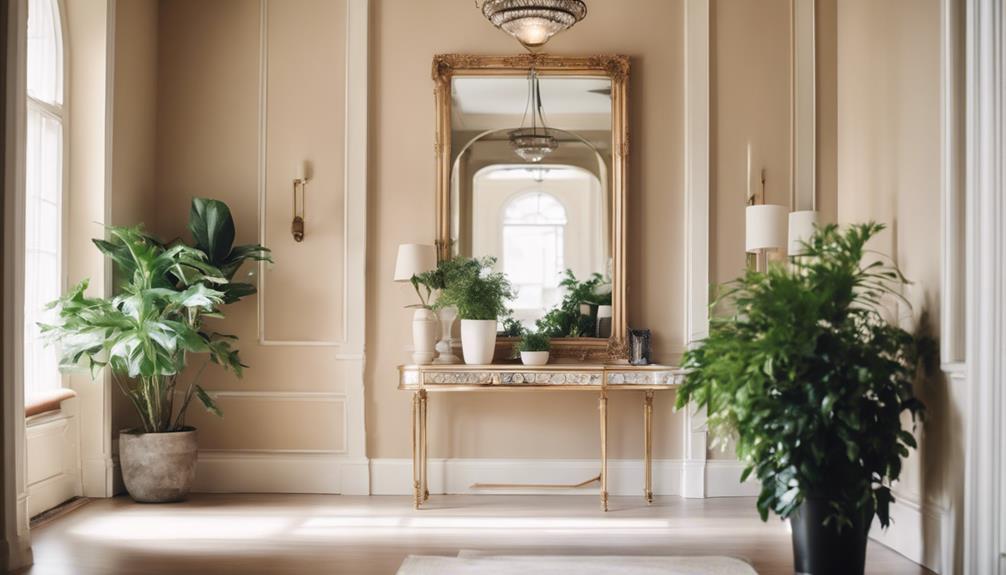
As we move forward with our hallway makeover, we're now focusing on the essential aspects of painting and decorating.
When it comes to selecting a color scheme, we need to take into account the overall aesthetic we want to achieve, factoring in the natural light, furniture, and decor that will complement our chosen hues.
Color Scheme Selection
How do we create a harmonious color scheme that not only complements the adjacent bold and vibrant wallpapered rooms but also transforms the narrow hallway into a bright and welcoming space?
We opted for Evergreen Fog SW 9130 from Sherwin-Williams, the 2022 Color of the Year, as our paint color of choice. To enhance the brightness and create a cohesive look, we chose a satin finish for the paint. By painting the hallway ceiling with Evergreen Fog, we can carry light farther down the hall, making it feel more spacious.
Personalization and style were key factors in selecting a color scheme that complements the adjacent rooms. We collaborated with Minted to design a gallery wall that adds a visually appealing touch to the hallway. The resulting color scheme isn't only harmonious but also reflects our personal style.
As we wanted the hallway to feel bright and welcoming, we made sure to select a color scheme that would achieve this goal. By incorporating our personal style and preferences, we were able to create a unique and inviting space that sets the tone for the rest of the house.
Decorating Accent Walls
By incorporating accent walls into our hallway design, we can strategically draw attention to specific areas, add visual interest, and create a sense of depth. Accent walls can transform a space by adding depth and visual interest through contrasting colors or textures.
Painting an accent wall can create a focal point in a room, drawing attention to architectural features or artwork.
Here are three ways to elevate the design of an accent wall:
- Stripes and patterns: Add a touch of sophistication with stripes, geometric patterns, or textured finishes.
- Bold colors: Make a statement with bold, contrasting colors or metallic paints for a dramatic effect.
- Unique materials: Incorporate wallpaper, wood paneling, or tile to create a one-of-a-kind accent wall that complements the room's decor.
Unveiling Hidden Designs
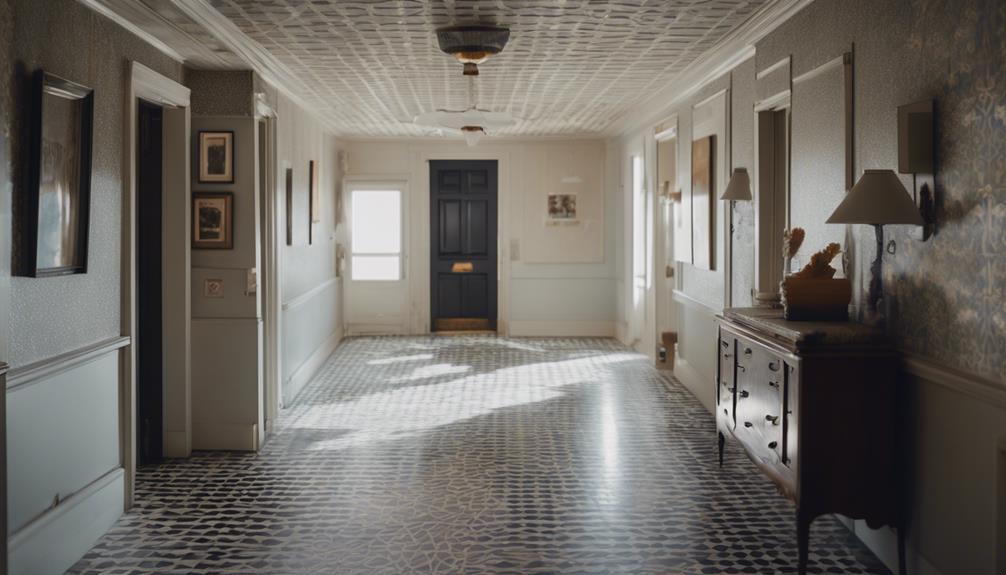
We began by removing old stickers from the doors, which revealed hidden designs that added a personal touch to our hallway makeover.
To remove the stickers, we utilized the vinegar method, soaking rags in vinegar and applying them to the stickers. This loosened the adhesive, making it easier to scrape them off. For more stubborn residue, we used electric sanders to smooth out the surface. We treated both sides of the doors with the vinegar method to guarantee complete sticker removal.
The result was astonishing – the hidden designs on the doors added a fresh and personalized touch to our hallway makeover. By removing the old stickers, we uncovered a unique aspect of our doors that complemented our design aesthetic. This subtle detail elevated our hallway makeover, making it truly remarkable.
As we worked on this project, we realized that sometimes, it's the smallest details that make the biggest impact.
Adding Personal Touches
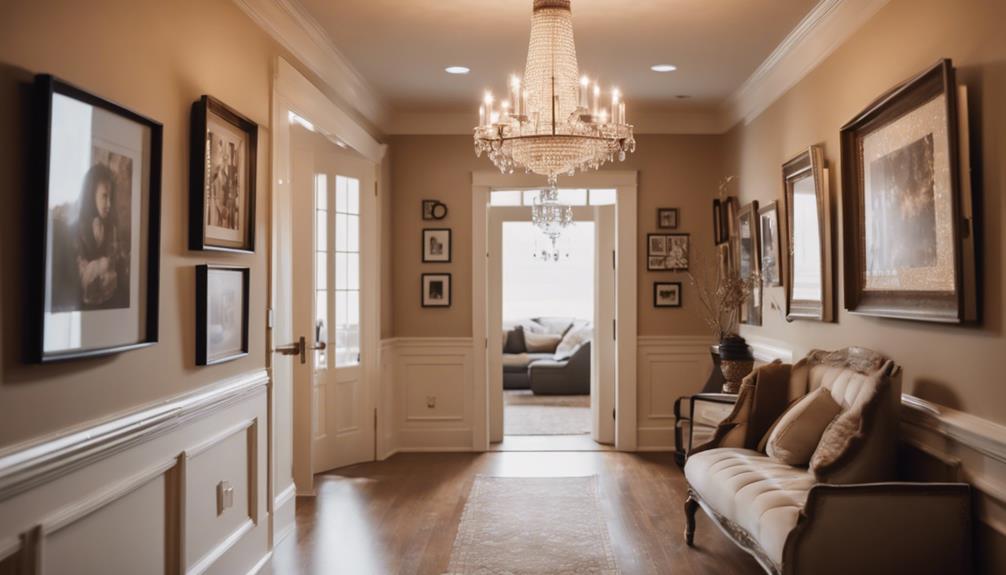
As we move on to adding personal touches to our hallway makeover, we're excited to explore the various ways to make this space truly reflective of our style and personality.
From showcasing unique artwork displays to creating a personalized photo gallery, we'll discover how incorporating meaningful decor pieces can elevate the overall aesthetic of our hallway.
Unique Artwork Displays
Incorporating unique artwork displays into our hallway makeover allows us to put our personal stamp on the space. By doing so, we can create a visually appealing and inviting atmosphere that reflects our personality and style.
Here are three ways we can make our hallway makeover stand out with unique artwork displays:
- Mix and match sizes and styles: Combining different frame sizes, shapes, and styles adds visual interest to our gallery wall.
- Incorporate unconventional items: Using vintage mirrors, upcycled decor pieces, or other unexpected items adds a touch of whimsy to our hallway decor.
- Opt for custom artwork: Commissioning a custom piece or creating our own DIY artwork allows us to add a truly one-of-a-kind touch to our hallway makeover.
Personalized Photo Gallery
A personalized photo gallery wall adds a unique and sentimental touch to our hallway makeover, allowing us to curate a visually appealing display of cherished memories. By incorporating family photos, we create a focal point in the hallway, making it a constantly evolving space that reflects our individual style preferences.
We can mix and match prints and mementos on a gallery wall to showcase our personal memories and experiences, making it a true reflection of who we are. This personalized approach to hallway design allows us to customize the space to our liking, making it feel truly our own.
As we curate our photo gallery, we're not just hanging pictures – we're telling our story. By incorporating personal photos, we're able to put our own spin on the traditional hallway makeover, making it a space that's truly one-of-a-kind.
As a result, our hallway makeover is transformed into a warm and inviting space that's bursting with personality.
Meaningful Decor Pieces
We take our hallway makeover to the next level by adding meaningful decor pieces that reflect our personality, interests, and experiences. These personal touches not only make our hallway unique but also create a warm and inviting atmosphere.
Here are a few ways to incorporate meaningful decor pieces into our hallway makeover:
- Family heirlooms: Adding antiques or family heirlooms can infuse our hallway with history and nostalgia.
- Personalized art: Displaying meaningful artwork or crafts created by family members can enhance our hallway's personalization.
- DIY projects: Customizing decor elements with DIY projects or handmade items can showcase our creativity and personal style.
Balancing Artwork and Decor
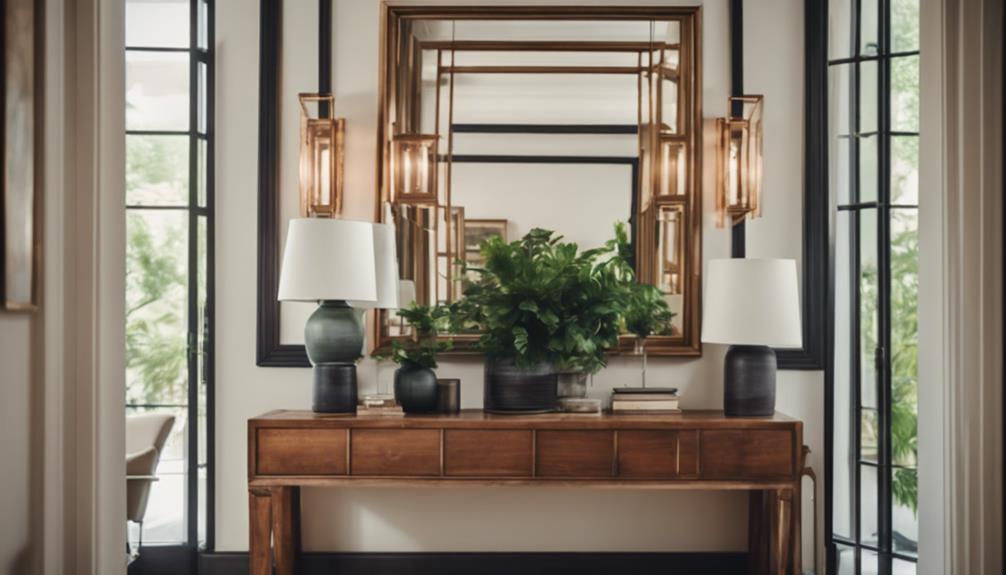
By thoughtfully arranging artwork and decor, we can create a visually appealing hallway that showcases our personal style. When it comes to balancing artwork and decor, the key is to create harmony and visual interest. We consider the size, color, and style of artwork to complement the hallway's design. Mixing and matching different types of art, like photography, paintings, and prints, adds dynamism to the display.
| Decor Element | Placement Tips | Visual Interest |
|---|---|---|
| Artwork | Group similar pieces together | Creates a focal point |
| Mirrors | Hang opposite windows for natural light | Adds depth and brightness |
| Lighting Fixtures | Install above or beside artwork | Highlights the piece |
| Furniture | Place at the end of the hallway for a sense of arrival | Creates a sense of warmth |
Final Touches and Reveals
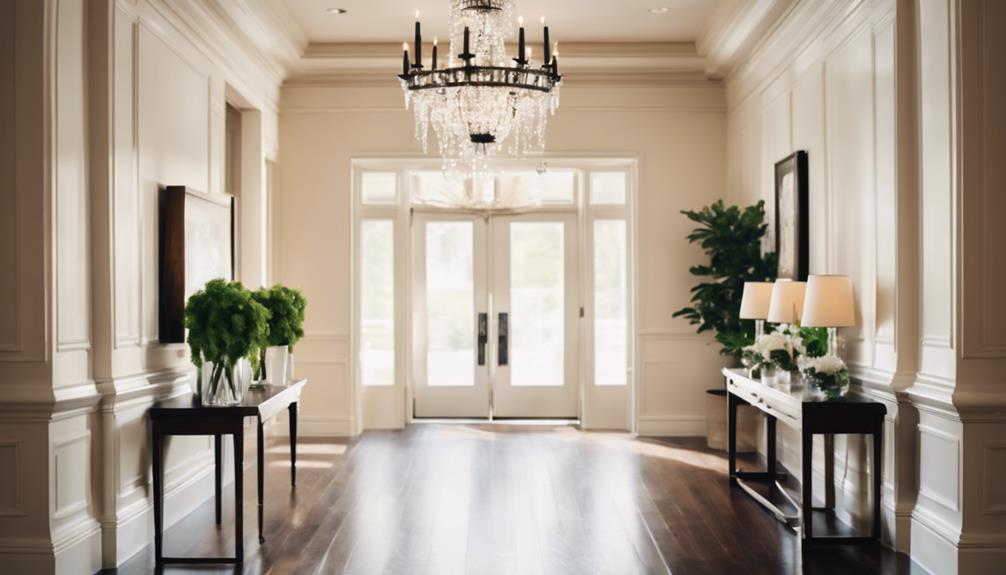
Now that our hallway's artwork and decor are thoughtfully arranged, it's time to put the finishing touches on our remarkable makeover. We're excited to add those final flourishes that will make our hallway look great. To add visual interest, we're incorporating a few key elements to elevate the space.
Here are a few of the details that will take our hallway to the next level:
- Collections of paintings: We're grouping a few of our favorite pieces together to create a cohesive look that adds depth and visual appeal.
- Pendant lights: These stylish fixtures won't only provide ample lighting but also add a touch of sophistication to our wide hallway.
- Large mirror: By placing a large mirror at the end of the hallway, we'll create the illusion of even more space and add a touch of glamour to the overall design.
With these final touches in place, we can't wait to stand back and admire our handiwork. Our hallway looks great, and we're thrilled with the results of our remarkable makeover.
Celebrating a Job Well Done
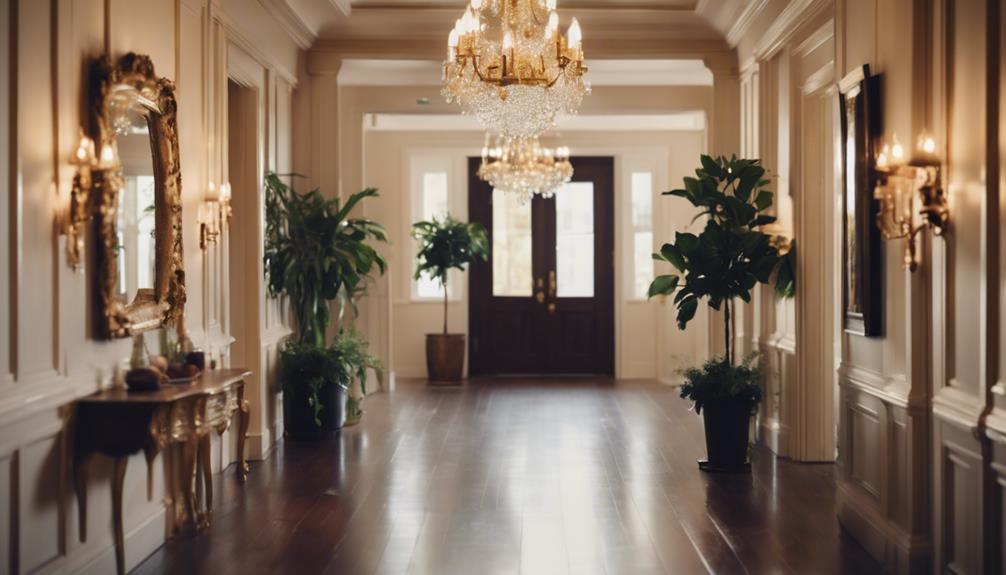
After a year-long renovation process, we're thrilled to stand back and admire our remarkable hallway makeover, reveling in the dramatic transformation from dark and outdated to light and airy. It's a moment to celebrate, and we're doing just that – celebrating a job well done.
The final touches, including personalization with decor and furniture, have enhanced the hallway's aesthetic appeal, making it a true showstopper. We're proud of the hard work that went into this hallway makeover, and it's evident in the enjoyment of the beautiful new decor and ambiance.
To mark the project's completion, we treated ourselves to a celebratory pizza and some well-deserved relaxation in our newly transformed space. As we gaze upon our handiwork, we can't help but feel a sense of accomplishment, knowing that our efforts have paid off.
This hallway makeover is more than just a renovation – it's a reflection of our perseverance and dedication.
Enjoying the New Ambiance
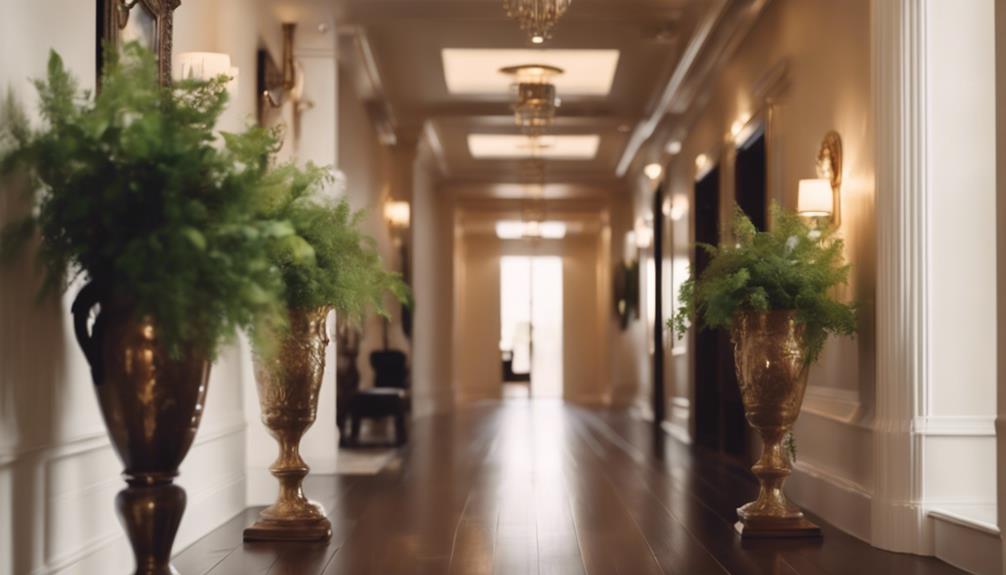
We're savoring every moment in our freshly renovated hallway, where the soft glow of new lighting and the soothing hue of fresh paint envelop us in a sense of serenity. The transformation is nothing short of remarkable, and we're thrilled to be enjoying the fruits of our labor.
Here's what we're loving about our new hallway space:
- Cozy atmosphere: The combination of fresh paint color, enhanced lighting, and personalized touches has created a warm and inviting ambiance that makes us feel right at home.
- Functional storage solutions: Our clever use of shelves and cabinets has maximized storage space, keeping clutter at bay and making it easy to find what we need.
- Personalized decor: From the gallery wall to the stylish accessories, every element has been carefully curated to reflect our personal style and make the space truly our own.
As we indulge in a well-deserved treat, we can't help but feel a sense of pride and accomplishment at the successful completion of our remarkable hallway makeover.
Frequently Asked Questions
How Can I Make My Hallway Look Good?
We're wondering how to make our hallway look good, and we're considering a few tricks to create a more inviting space – adding mirrors, a gallery wall, and some stylish lighting to make it feel more spacious and stylish.
How to Modernise a Hallway?
As we step into our humble abode, we envision a sleek, modern oasis, a far cry from the drab, cramped hallways of yesteryear. To modernize our hallway, we'll swap outdated fixtures for sleek, minimalist designs and infuse the space with vibrant hues and clever storage solutions.
How to Make a Long Hallway More Interesting?
We're tired of our long hallway feeling dull, so we're adding visual interest with a mix of art pieces, bold runners, and strategically placed mirrors to create a more engaging space that reflects our style.
How to Decorate Awkward Hallways?
As we navigate life's twists and turns, we often find ourselves stuck in awkward hallways, but we're not lost, we're just redirecting – we'll cleverly use mirrors, bold art, and stylish lighting to turn these spaces into grand entrances.
Conclusion
As we step back to admire our remarkable hallway makeover, we can't help but feel a sense of pride and accomplishment.
One potential concern, 'Will a bold design choice overwhelm the space?' is alleviated by the clever balancing of artwork and decor. According to interior design expert, Sarah Taylor, 'A well-curated mix of textures, colors, and patterns creates visual interest without overwhelming the senses.'
Our transformed hallway is now a warm, inviting space that showcases our personal style.
Home Decor
How to Paint Over Mirrors: A Step-By-Step Guide for You
Spruce up your space with a stunning makeover, but first, uncover the surprising techniques to paint over mirrors like a pro.
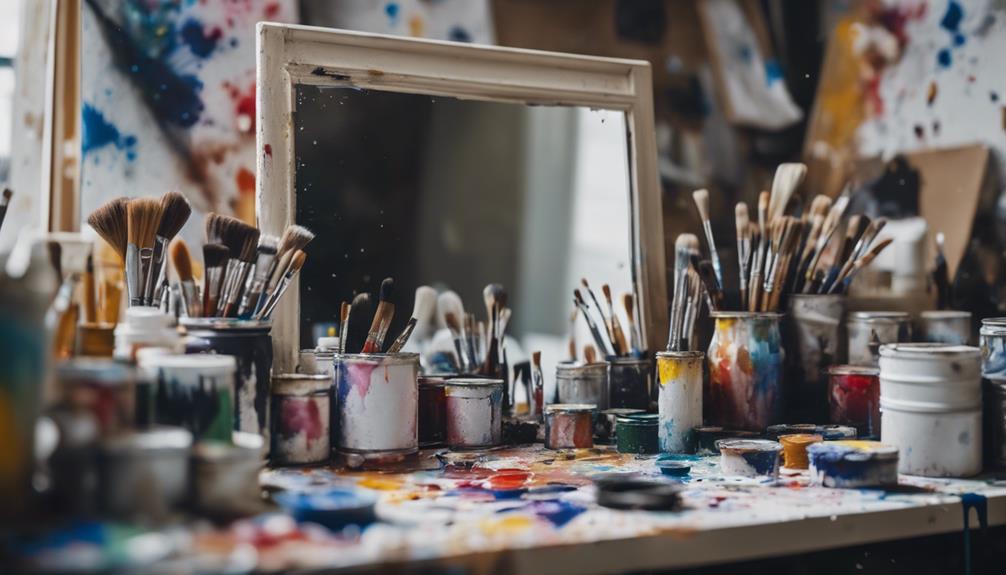
To breathe new life into an old mirror, start by cleaning the surface with glass cleaner, followed by priming with spray primer for a strong bond. Use chalk paint specifically designed for mirrors, applying it in light, even coats. Mask off areas with painter's tape to create crisp lines, and touch up edges with acrylic paint and a fine brush. Seal your masterpiece with a clear acrylic sealer for added protection. Finally, apply a topcoat designed for glass surfaces to guarantee durability. Now that you've got the basics down, you're ready to discover the secrets to a truly transformed mirror – and it all starts with the next step.
Key Takeaways
• Clean the mirror surface with glass cleaner to ensure proper adhesion of the paint.
• Use chalk paint for its adhesion properties to prevent peeling or chipping.
• Prime the mirror's surface with spray primer for a strong bond and durability.
• Apply high-quality spray paint designed for mirrors in light, even coats for even coverage.
• Seal the painted mirror with a clear acrylic sealer for added protection.
Prepare the Mirror Surface
Before you can start painting, you'll need to thoroughly clean the mirror surface with a glass cleaner to remove any dirt, dust, or residue that may interfere with paint adhesion. This vital step guarantees a strong bond between the mirror and the paint, preventing peeling or chipping over time.
Once the mirror surface is clean, you're ready to move on to the next step. Since you'll be using chalk paint, which is known for its excellent adhesion properties, you can feel confident that your paint job will last. However, it's still essential to take the time to properly prepare the surface to achieve the best results.
Clean the Mirror Frame
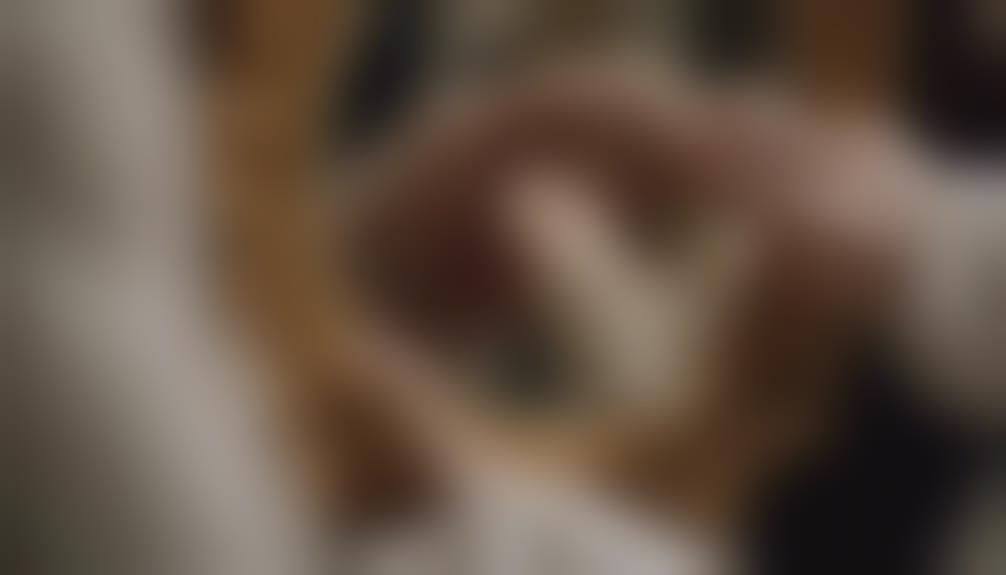
With your mirror surface sparkling clean, turn your attention to the frame, where a mixture of water and mild detergent awaits to help you scrub away dust, dirt, and grime. This important step guarantees a clean mirror frame, essential for proper paint adhesion and a professional-looking finish.
Using a microfiber cloth or sponge, gently scrub the frame, paying special attention to corners and intricate details. Remove any residue, making sure all surfaces are clean and dry. Allow the frame to dry completely after cleaning to prevent any moisture from affecting the adhesion of the paint.
A clean mirror frame is crucial, as it provides a smooth surface for painting. Take your time to thoroughly clean the frame, and you'll be rewarded with a beautifully painted mirror that looks like new. By cleaning the mirror frame, you're setting yourself up for success and ensuring a stunning final result.
Prime the Mirror
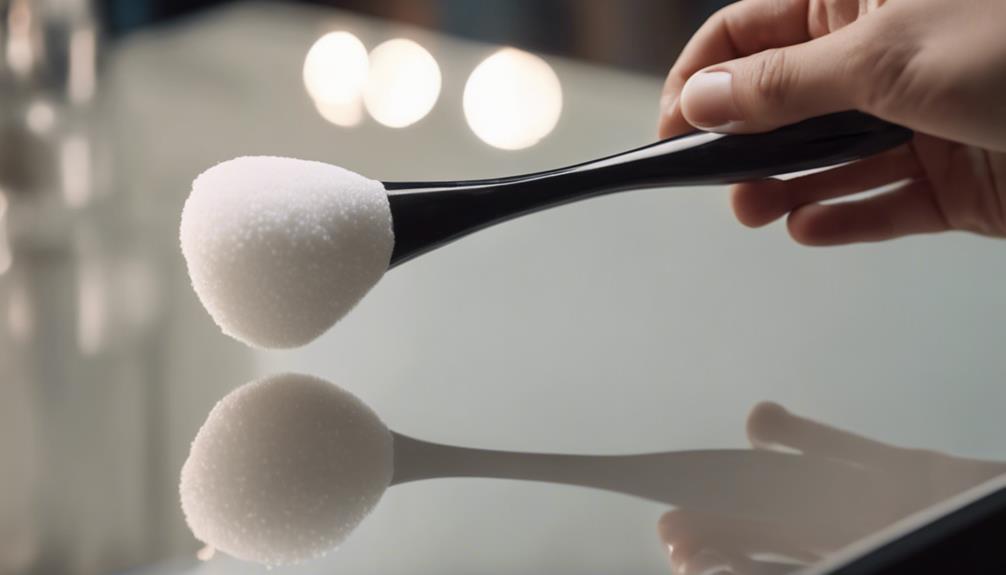
As you move on to the next step, it's crucial to focus on preparing the mirror's surface for painting.
Now that you've cleaned the mirror frame, you'll need to prime the mirror itself, which involves cleaning the surface and applying a primer coat to establish a strong bond between the paint and the mirror.
Cleaning the Surface
You'll need to give your mirror a thorough cleaning to guarantee a strong bond between the mirror and the paint. This step is crucial, as any dirt, grime, or residue can affect the paint's adhesion. Reach for a trusted glass cleaner and spray it onto the mirror's surface. Wipe it down with a lint-free cloth or paper towel, making sure to remove any streaks or residue. If you want to add an extra layer of cleanliness, mix a mild detergent with water or use a vinegar solution to remove any oils or fingerprints.
| Cleaning Supplies | Purpose | Tips |
|---|---|---|
| Glass Cleaner | Removes dirt and grime | Use a lint-free cloth or paper towel |
| Mild Detergent | Removes oils and fingerprints | Mix with water for a gentle solution |
| Vinegar Solution | Removes oils and fingerprints | Dilute with water for a gentle solution |
Applying Primer Coat
Now that your mirror is sparkling clean, it's time to prime the surface to guarantee a strong bond between the mirror and paint. Applying a primer coat is an important step in ensuring a professional-looking finish and a long-lasting paint job. When you prime the mirror frame, you're promoting adhesion and durability, which prevents chipping or peeling of the paint.
To do this, use a spray primer for easy application and even coverage on the mirror frame. Hold the can 8-10 inches away from the surface and move it back and forth, applying a light coat evenly. Make sure to follow the manufacturer's instructions for drying time before moving on to the next step.
Paint the Mirror Design
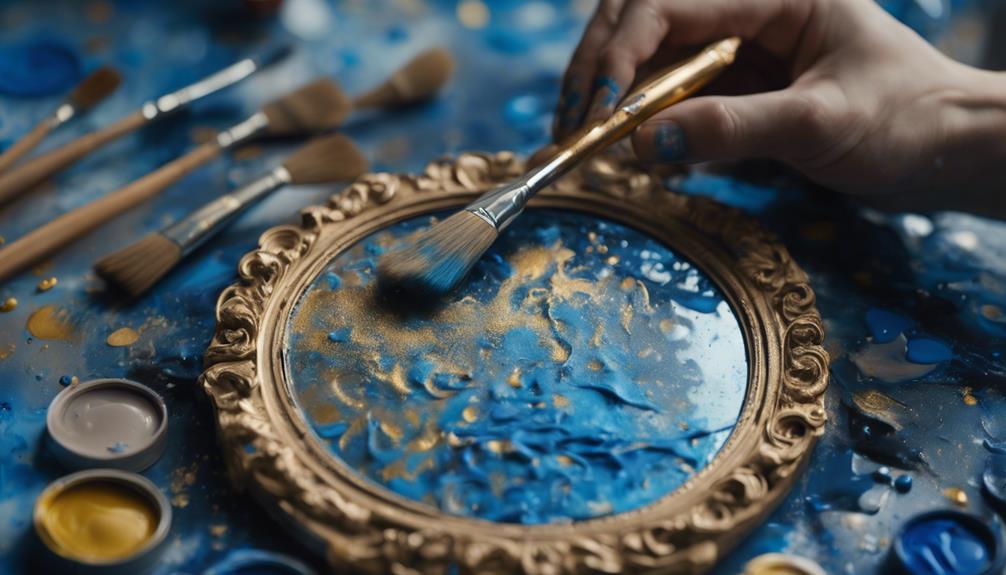
With your mirror detached or masked, start by applying a light coat of primer to the frame, making sure to cover all angles for an even finish. As an Amazon Associate, I recommend using a high-quality spray paint specifically designed for mirrors to achieve a stroke-free finish. Hold the can 8-10 inches away from the frame and spray in a steady, back-and-forth motion, covering the entire surface.
Make sure to apply light coats, guaranteeing each coat to dry before applying the next. This will prevent drips and secure a smooth finish. You can use a small brush to touch up any areas the spray paint may have missed. Remember to spray from all angles to achieve even coverage on the mirror frame.
Once you've achieved the desired color, let the final coat dry completely before moving on to the next step.
Remove Masking and Tape
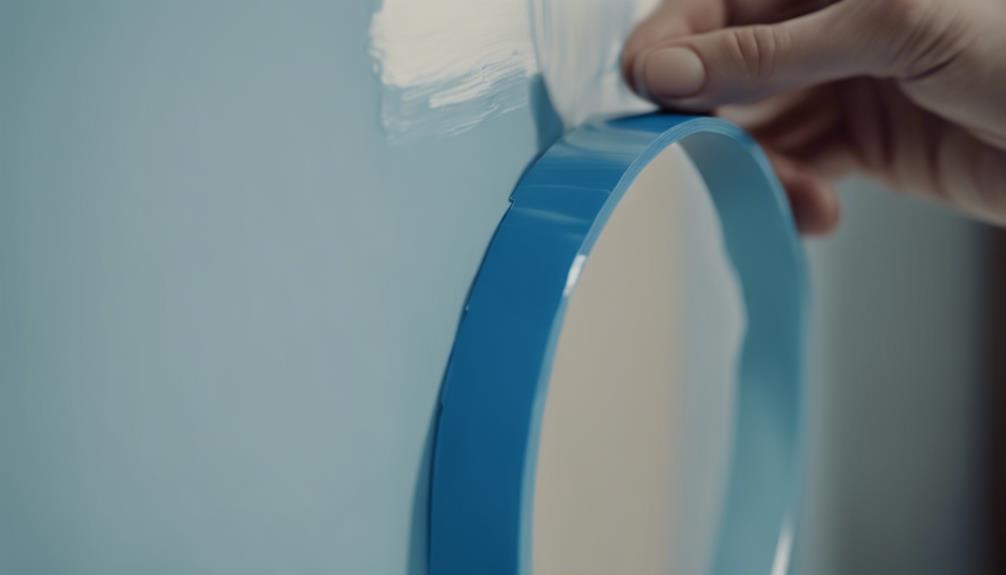
After applying the final coat of paint, it's time to remove the masking and tape from the mirror frame to reveal the beautifully painted design. This is an exciting step, as you get to see your hard work come together.
| Step | Action | Tips |
|---|---|---|
| 1 | Peel off masking tape and painter's tape | Use a gentle touch to avoid scratching the mirror |
| 2 | Remove excess paint | Use a razor blade or craft knife to lift paint off the mirror surface |
| 3 | Clean the mirror | Use glass cleaner to remove residue left behind by the tape |
| 4 | Inspect the mirror | Check for any remaining paint marks or smudges that need attention |
As you remove the tape, use a gentle touch to avoid scratching the mirror. You may need to use a razor blade or craft knife to gently lift any paint that may have seeped onto the mirror surface. After cleaning the mirror with glass cleaner, inspect it closely for any remaining paint marks or smudges that need to be addressed. Once you've completed these steps, you can enjoy your newly painted mirror without any masking or tape remnants detracting from its beauty.
Touch Up Mirror Edges
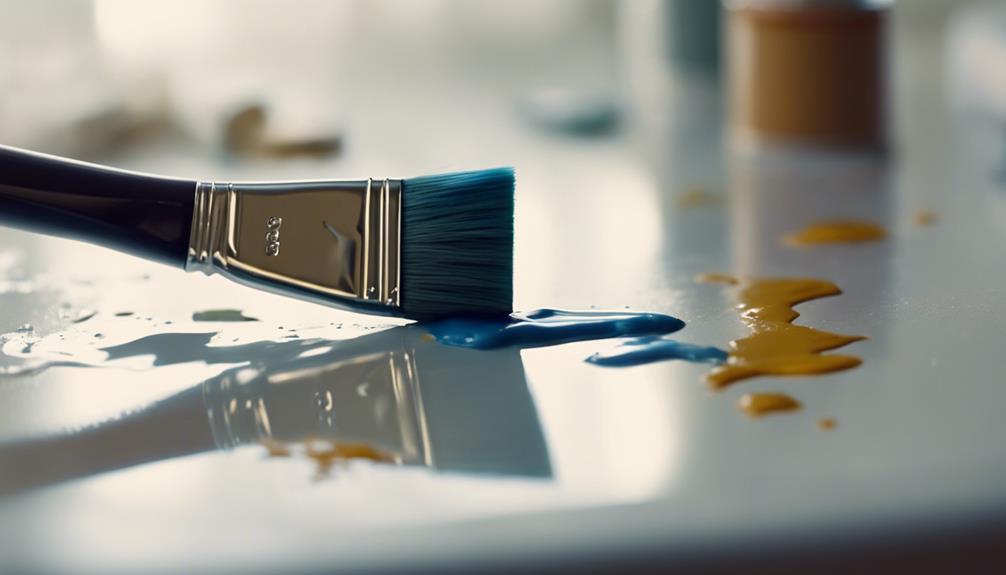
Guarantee the mirror edges are carefully painted, using a small, fine paintbrush to achieve a professional finish.
You want to make sure that the paint only reaches the edges, so apply a thin layer of painter's tape along the edges of the mirror to create a clean line. This will prevent any paint from seeping onto the mirror's surface.
Next, use a high-quality acrylic paint specifically designed for glass surfaces to carefully touch up the mirror edges. Work methodically, using smooth, even strokes to cover the entire edge. Remember to maintain a steady hand and take your time – it's better to apply multiple thin coats than to risk applying too much paint at once.
Once you've completed the edges, allow the paint to dry completely before removing the painter's tape to reveal crisp, freshly painted mirror edges.
With patience and attention to detail, you'll achieve a flawless, professional-looking finish.
Seal the Painted Mirror
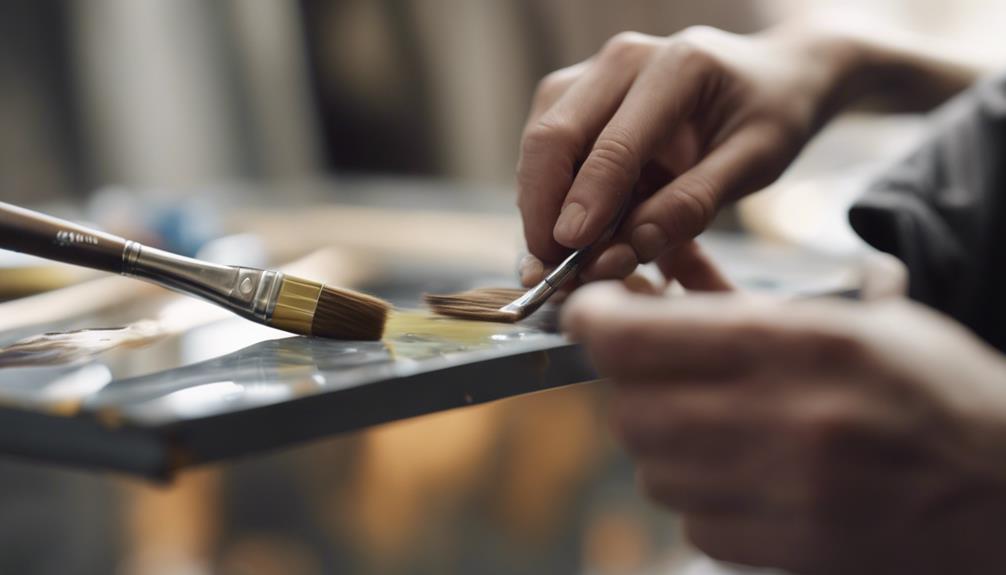
As you move forward with sealing your painted mirror, you'll want to focus on two key points: protecting the paint job and adding a topcoat.
By doing so, you'll guarantee your DIY project remains vibrant and durable for years to come.
Protecting the Paint Job
Completing your painted mirror with a clear acrylic sealer is important to safeguarding your artwork from scratches and damage. This step is vital in guaranteeing your hard work lasts for years to come.
By applying a clear acrylic sealer, you're adding an extra layer of protection against the elements and daily wear and tear.
Here are some key takeaways to keep in mind when sealing your painted mirror:
- Choose a high-quality sealer suitable for glass surfaces to ensure long-lasting durability.
- Apply the sealer in thin, even coats to prevent drips or streaks on the painted mirror.
- Allow each layer of sealer to dry completely before applying additional coats for best protection.
- Regularly clean and maintain the sealed painted mirror to preserve its appearance and longevity.
- Be patient and take your time when applying the sealer, as this will ensure a professional-looking finish.
Adding a Topcoat
With your painted mirror fully dry, you're ready to seal in your artwork with a clear topcoat, the final protective layer that will shield your masterpiece from scratches and wear. This step is vital to guarantee your design lasts for a long time.
When choosing a topcoat, select one specifically designed for use on glass surfaces, as it will provide better adhesion and durability. Before applying the topcoat, make sure the painted mirror is completely dry to prevent smudging or an uneven finish.
Follow the manufacturer's instructions for the topcoat application process to ensure a smooth and long-lasting result. A clear topcoat with a gloss or satin finish can enhance the painted mirror's appearance, giving it a professional look.
Hang Your New Masterpiece
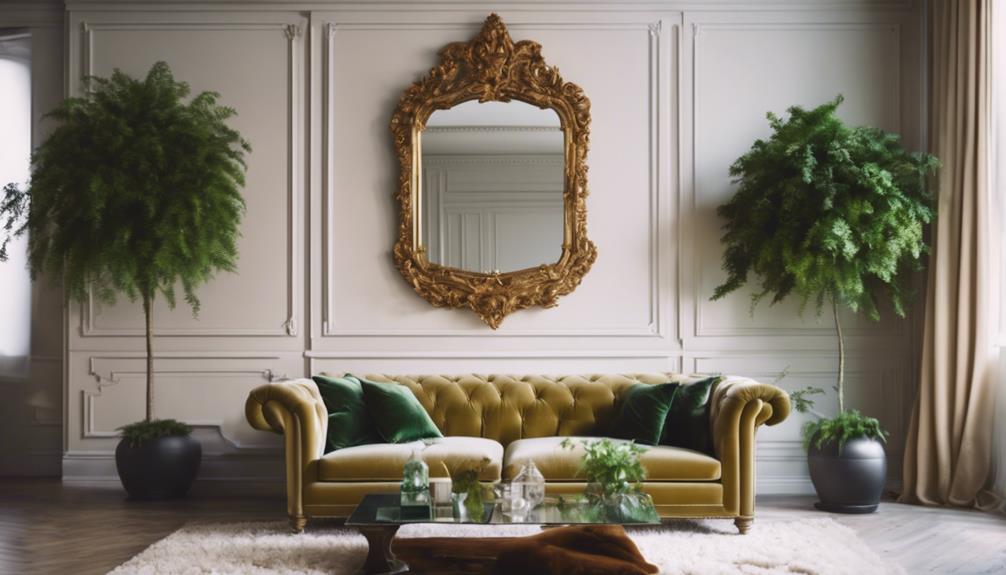
You're ready to hang your newly painted mirror, and a few final checks will guarantee it's securely in place. After investing so much time and effort into transforming your mirror, you want to make sure it's properly secured to the wall.
Here are the final steps to complete the process:
- Clean the frame one final time to remove any lingering dust or residue before hanging your newly painted mirror.
- Check the hanging hardware on the back of the mirror to make sure it's secure and can support the weight of the mirror.
- Use appropriate wall anchors or screws to hang the mirror securely, considering the weight and size of the mirror.
- Measure and mark the desired placement of the mirror on the wall before hanging to ensure proper alignment.
- Step back and admire your transformed mirror, appreciating the new look it brings to the space.
Frequently Asked Questions
How to Paint Over a Mirror?
When you're wondering how to paint over a mirror, remember to cover the mirror's surface with masking tape or detach it from the frame to prevent paint from seeping underneath.
Then, prime the frame with spray primer for better paint adhesion.
Apply light, even coats of spray paint from different angles, ensuring complete coverage.
Can I Use Acrylic Paint on a Mirror?
You're probably wondering if you can use acrylic paint on a mirror – and the answer is a resounding yes!
In fact, acrylic paint adheres amazingly well to glass surfaces, making it a fantastic choice for decorative projects or unique art pieces.
With its quick-drying properties, you'll be amazed at how swiftly you can transform your mirror into a stunning work of art.
What Do You Cover a Mirror With When Painting?
When painting around a mirror, you'll want to cover it to prevent paint from getting on the reflective surface. You can use painter's tape or masking tape to cover the mirror, and for added protection, layer newspaper or brown kraft paper on top, securing it with tape.
Alternatively, you can use plastic drop cloths or garbage bags to cover the mirror. Just make sure the covering is tightly secured to prevent any paint seepage.
Does Spray Paint Work on Mirrors?
You're likely wondering: does spray paint work on mirrors?
The answer is yes, it does! In fact, spray paint is a great option for painting mirrors, offering a stroke-free finish and easy application.
It's perfect for accessing tight angles and corners on the mirror frame, ensuring even coverage. Plus, it's a quick and cost-effective way to refresh your mirror's look.
Conclusion
As you step back to admire your handiwork, the transformed mirror reflects not only your new design, but also your resourcefulness and creativity.
Like a phoenix rising from the ashes, your once-bare mirror now boasts a fresh, vibrant personality, ready to elevate any room.
With each brushstroke, you've not only painted over the mirror but also infused it with a piece of yourself – a symbol of the power of transformation and self-expression.
Vivienne – Your Content Companion Vivienne is your content companion, curating valuable tips, advice, and inspiration to guide you on your home decor journey. From insightful blog posts to informative product descriptions, she’s here to empower you with the knowledge you need to create your dream space.
-

 Craft and Textiles2 months ago
Craft and Textiles2 months ago15 Best Places to Buy Appliances for Your Home – Top Retailers Reviewed
-

 Decorative Throws2 months ago
Decorative Throws2 months agoIs It Better to Dry Clean Blankets?
-

 Vetted3 weeks ago
Vetted3 weeks ago14 Best Personalized Father's Day Gifts for Your Husband – Show Him You Care
-

 Yarn2 months ago
Yarn2 months agoIs Yarn Natural or Manmade? Unravel the Truth
-

 Tableware and Dining Accessories2 months ago
Tableware and Dining Accessories2 months agoWhat Is the Meaning of the Word Tableware
-

 Tableware and Dining Accessories2 months ago
Tableware and Dining Accessories2 months agoWhat Is the Hindi Meaning of Tableware
-

 Craft and Textiles2 months ago
Craft and Textiles2 months ago15 Best Cordless Mowers for Effortless Lawn Care – Top Picks of 2024
-

 Craft and Textiles2 months ago
Craft and Textiles2 months ago15 Best Battery-Powered Leaf Blowers for Effortless Yard Work



















